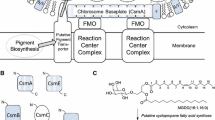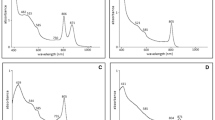Abstract
The compositions of glycolipids in the following seven strains of green photosynthetic bacteria were investigated at the molecular level using LC–MS coupled with an evaporative light scattering detector: Chlorobium (Chl.) limicola strains Larsen (30 °C as the optimal cultivation temperature) and DSM245 (30 °C), Chlorobaculum (Cba.) tepidum strain ATCC49652 (45 °C), Cba. parvum strain NCIB8327 (30 °C), Cba. limnaeum strain 1549 (30 °C), Chl. phaeovibrioides DSM269 (30 °C), and Chloroflexus (Cfl.) aurantiacus strain J-10-fl (55 °C). Dependence of the molecular structures of glycolipids including the chain-length of their acyl groups upon bacterial cultivation temperatures was clearly observed. The organisms with their optimal temperatures of 30, 45, and 55 °C dominantly accumulated glycolipids possessing the acyl chains in the range of C15–C16, C16–C17, and C18–C20, respectively. Cba. tepidum with an optimal temperature of 45 °C preferred the insertion of a methylene group to produce finally a C17-cyclopropane chain. Cfl. aurantiacus cultured optimally at 55 °C caused a drastic increase in the chain-length. Notably, the length of such acyl groups corresponded to that of the esterifying chain in the 17-propionate residues of self-aggregative bacteriochlorophylls-c/d/e, indicating stabilization of their supramolecular structures through hydrophobic interactions among those hydrocarbon chains. Based on the detailed compositions of glycolipids, a survival strategy of green photosynthetic bacteria grown in the wide range of temperatures is discussed.




Similar content being viewed by others
Abbreviations
- BChl:
-
Bacteriochlorophyll
- Cba. :
-
Chlorobaculum
- Cfl. :
-
Chloroflexus
- Chl. :
-
Chlorobium
- DGDG:
-
Digalactosyldiacylglyceride
- ELSD:
-
Evaporative light scattering detector
- ESI:
-
Electrospray ionization
- FMO protein:
-
Fenna–Matthews–Olson protein
- MGDG:
-
Monogalactosyldiacylglyceride
- RGDG:
-
Rhamnosylgalactosyldiacylglyceride
References
Balaban TS, Tamiaki H, Holzwarth AR (2005) Chlorins programmed for self-assembly. In: Würthner F (ed) Supramolecular dye chemistry (Topics Curr Chem vol. 258). Springer, Heidelberg, pp 1–38
Balogi Z, Török Z, Balogh G, Jósvay K, Shigapova N, Vierling E, Vigh L, Horváth I (2005) “Heat shock lipid” in cyanobacteria during heat/light-acclimation. Arch Biochem Biophys 436:346–354
Blankenship RE, Matsuura K (2003) Antenna complexes from green photosynthetic bacteria. In: Green BR, Parson WW (eds) Light-harvesting antennas in photosynthesis. Kluwer, Dordrecht, pp 195–217
Bligh EG, Dyer WJ (1959) A rapid method of total lipid extraction and purification. Can J Biochem Physiol 37:911–917
Borrego CM, Garcia-Gil LJ (1994) Separation of bacteriochlorophyll homologues from green photosynthetic sulfur bacteria by reversed-phase HPLC. Photosynth Res 41:157–163
Chew AGM, Bryant DA (2007) Chlorophyll biosynthesis in bacteria: the origins of structural and functional diversity. Annu Rev Microbiol 61:113–129
Costas AMG, Tsukatani Y, Rijpstra WIC, Schouten S, Welander PV, Summons RE, Bryant DA (2012) Identification of the bacteriochlorophylls, carotenoids, quinones, lipids, and hopanoids of “Candidatus Chloracidobacterium thermophilum”. J Bacteriol 194:1158–1168
Fages F, Griebenow N, Griebenow K, Holzwarth AR, Schaffner K (1990) Characterization of light-harvesting pigments of Chloroflexus aurantiacus. Two new chlorophylls: oleyl (octadec-9-enyl) and cetyl (hexadecanyl) bacteriochlorophyllides-c. J Chem Soc Perkin Trans 1:2791–2797
Frigaard NU, Chew AGM, Maresca JA, Bryant DA (2006) Bacteriochlorophyll biosynthesis in green bacteria. In: Grimm B, Porra RJ, Rüdiger W, Scheer H (eds) Chlorophylls and bacteriochlorophylls: biochemistry, biophysics, functions and applications. Springer, Dordrecht, pp 201–221
Glaeser J, Bañeras L, Rütters H, Overmann J (2002) Novel bacteriochlorophyll e structures and species-specific variability of pigment composition in green sulfur bacteria. Arch Microbiol 177:475–485
Harada J, Miyago S, Mizoguchi T, Azai C, Inoue K, Tamiaki H, Oh-oka H (2008) Accumulation of chlorophyllous pigments esterified with the geranylgeranyl group and photosynthetic competence in the CT2256-deleted mutant of the green sulfur bacterium Chlorobium tepidum. Photochem Photobiol Sci 7:1179–1187
Harada J, Mizoguchi T, Tsukatani Y, Noguchi M, Tamiaki H (2012) A seventh bacterial chlorophyll driving a large light-harvesting antenna. Sci Rep 2:671. doi:10.1038/srep00671
Härtig C, Loffhagen N, Babel W (1999) Glucose stimulates a decrease of the fatty acid saturation degree in Acinetobacter calcoaceticus. Arch Microbiol 171:166–172
Holo H, Broch-Due M, Ormerod JG (1985) Glycolipids and the structure of chlorosomes in green bacteria. Arch Microbiol 143:94–99
Imhoff JF, Bias-Imhoff U (1995) Lipids, quinones and fatty acids of anoxygenic phototrophic bacteria. In: Blankenship RE, Madigan MT, Bauer CE (eds) Anoxygenic photosynthetic bacteria. Kluwer, Dordrecht, pp 179–205
James AM, John LH (1967) Ring location in cyclopropane fatty acid esters by a mass spectrometric method. Lipids 2:225–230
Knudsen E, Jantzen E, Bryn K, Ormerod JG, Sirevåg R (1982) Quantitative and structural characteristics of lipids in Chlorobium and Chloroflexus. Arch Microbiol 132:149–154
Loffhagen N, Härtig C, Benndorf D, Babel W (2002) Effects of growth temperature and lipophilic carbon sources on the fatty acid composition and membrane liquid fluidity of Acinetobacter calcoaceticus 69 V. Acta Biotechnol 22:235–243
Masuda S, Harada J, Yokono M, Yuzawa Y, Shimojima M, Murofushi K, Tanaka H, Masuda H, Murakawa M, Haraguchi T, Kondo M, Nishimura M, Yuasa H, Noguchi M, Oh-oka H, Tanaka A, Tamiaki H, Ohta H (2011) A monogalactosyldiacylglycerol synthase found in the green sulfur bacterium Chlorobaculum tepidum reveals important roles for galactolipids in photosynthesis. Plant Cell 23:2644–2658
Miyatake T, Tamiaki H (2005) Self-aggregates of bacteriochlorophylls-c, d and e in a light-harvesting antenna system of green photosynthetic bacteria: effect of stereochemistry at the chiral 3-(1-hydroxyethyl) group on the supramolecular arrangement of chlorophyllous pigments. J Photochem Photobiol C 6:89–107
Mizoguchi T, Yoshitomi T, Harada J, Tamiaki H (2011) Temperature- and time-dependent changes in the structure and composition of glycolipids during the growth of the green sulfur photosynthetic bacterium Chlorobaculum tepidum. Biochemistry 50:4504–4512
Oelze J, Golecki JR (1995) Membranes and compositions of green bacteria: structure, composition and development. In: Blankenship RE, Madigan MT, Bauer CE (eds) Anoxygenic photosynthetic bacteria. Kluwer, Dordrecht, pp 259–278
Olson JM (1998) Chlorophyll organization and function in green photosynthetic bacteria. Photochem Photobiol 67:61–75
Pedersen MØ, Borch A, Højrup P, Cox RP, Miller M (2006) The light-harvesting antenna of Chlorobium tepidum: interactions between the FMO protein and the major chlorosome protein CsmA studied by surface plasmon resonance. Photosynth Res 89:63–69
Pierson BK, Castenholz RW (1974) A phototrophic gliding filamentous bacterium of hot springs, Chloroflexus aurantiacus, gen. and sp. nov. Arch Microbiol 100:5–24
Saga Y, Tamiaki H (2006) Transmission electron microscopic study on supramolecular nanostructures of bacteriochlorophyll self-aggregates in chlorosomes of green photosynthetic bacteria. J Biosci Bioeng 102:118–123
Seiwert B, Giavalisco P, Willmitzer L (2009) Advanced mass spectrometry methods for analysis of lipids from photosynthetic organisms. In: Wada H, Murata N (eds) Lipids in photosynthesis: essential and regulatory functions. Springer, Dordrecht, pp 445–461
Sørensen PG, Cox RP, Miller M (2008) Chlorosome lipids from Chlorobium tepidum: characterization and quantification of polar lipids and wax esters. Photosynth Res 95:191–196
Staehelin LA, Golecki JR, Drews G (1980) Supramolecular organization of chlorosomes and of their membranes attachment sites in Chlorobium limicola. Biochim Biophys Acta 589:30–45
Tamiaki H, Shibata R, Mizoguchi T (2007) The 17-propionate function of (bacterio)chlorophylls: biological implication of their long esterifying chains in photosynthetic systems. Photochem Photobiol 83:152–162
Vogl K, Tank M, Orf GS, Blankenship RE, Bryant DA (2012) Bacteriochlorophyll f: properties of chlorosomes containing the “forbidden chlorophyll”. Front Microbiol 3. doi:10.3389/fmicb.2012.00298
Wahlund TM, Woese CR, Castenholz RW, Madigan MT (1991) A thermophilic green sulfur bacterium from New Zealand hot springs, Chlorobium tepidum sp. nov. Arch Microbiol 156:81–90
Wang AY, Cronan JE Jr (1994) The growth phase-dependent synthesis of cyclopropane fatty acids in Escherichia coli is the result of an RpoS (KatF)-dependent promoter plus enzyme instability. Mol Microbiol 11:1009–1017
Wieslander Å, Christiansson A, Rilfors L, Lindblom G (1980) Lipid bilayer stability in membranes. Regulation of lipid composition in Acholeplasma laidlawii as governed by molecular shape. Biochemistry 19:3650–3655
Wieslander Å, Rilfors L, Lindblom G (1986) Metabolic changes of membrane lipid composition in Acholeplasma laidlawii by hydrocarbons, alcohols, and detergents: arguments for effects on lipid packing. Biochemistry 25:7511–7517
Yoshitomi T, Mizoguchi T, Kunieda M, Tamiaki H (2011) Characterization of glycolipids in light-harvesting chlorosomes from the green photosynthetic bacterium Chlorobium tepidum. Bull Chem Soc Jpn 84:395–402
Acknowledgments
We thank Dr. H. Oh-oka of Osaka University for his provision of Chl. limicola strain Larsen, Mr. D. Shoutsu, Mr. M. Miyoshi, Dr. K. Nakagawa and Dr. S. Kawana of Shimadzu Corporation for their GC–MS analyses of aliphatic acid methyl esters, and Dr. Y. Tsukatani of Ritsumeikan University for his useful discussion. This study was partially supported by Grants-in-Aid for Scientific Research (A) (No. 22245030) (to HT) and (C) (No. 24550065) (to TM) as well as for Young Scientists (B) (No. 24750169) (to JH) from the Japan Society for the Promotion of Science (JSPS).
Author information
Authors and Affiliations
Corresponding author
Electronic supplementary material
Below is the link to the electronic supplementary material.
Rights and permissions
About this article
Cite this article
Mizoguchi, T., Harada, J., Yoshitomi, T. et al. A variety of glycolipids in green photosynthetic bacteria. Photosynth Res 114, 179–188 (2013). https://doi.org/10.1007/s11120-013-9802-9
Received:
Accepted:
Published:
Issue Date:
DOI: https://doi.org/10.1007/s11120-013-9802-9




